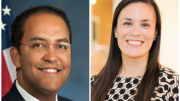Special American Red Cross Disaster Preparedness Poll/Siena College COMD210 Class
- Aside from COVID-19, NY’ers Most Concerned with Terrorist Attack, Another Pandemic, Home Fire
- 64% Prepared for a Natural Disaster; 80% Familiar with Basic Fire Safety Measures
- 91% Have at Least One Smoke Alarm; 61% Have Fire Escape Plan But Nearly Half Never Practice; 35% Don’t Have Place to Stay If Lost Home in a Fire
Crosstabs Press Release Presentation
Loudonville, NY. Currently almost all New Yorkers are concerned about the spread of the coronavirus, but looking to the future, they are most concerned about a terrorist or other mass violence attack followed by another pandemic or a home fire according to a new statewide online survey of New Yorkers conducted by a Siena College student research team in partnership with the American Red Cross of Eastern New York. Nineteen percent say that they are very prepared while an additional 45 percent are somewhat prepared for a natural disaster such as a hurricane, flood or blizzard.
Fifty-five percent are somewhat or very concerned that they will experience a home fire in the next three years but only nine percent think it is the disaster – natural, terrorist, or public health – most likely to occur and although a fire is the greatest concern of 13 percent of state residents, more are concerned with terrorism (26 percent) and another pandemic (24 percent).
Eighty percent say they are somewhat (43 percent) or very (37 percent) familiar with basic fire safety measures such as how often to test or change a smoke alarm. Nearly all New Yorkers, 91 percent, have at least one smoke alarm in their household and 61 percent have a fire escape plan in place for their household. Not only do 39 percent not have an escape plan, but of those that do, 46 percent have not practiced their plan in the past 12 months.
“Eighty percent may say they are familiar with fire safety, but 100 percent not 61 percent need a practiced escape plan in order to be safe” said Liam Stewart, one of the student researchers. “And with nearly a third failing to test their smoke alarm at least a few times a year, a quarter lacking a separate carbon monoxide detector and over a third not having a place to stay after a fire, the truth is, many of us just aren’t adequately prepared for a fire.”
Odds & Ends
- In addition to being concerned that at some point in the next three years that they will experience a terrorist attack, another pandemic or a home fire, 73 percent are concerned with a cyber attack, 60 percent with a severe blizzard, 53 percent with a major infrastructure failure, 44 percent with major flooding, 35 percent with an earthquake and 34 percent with a tornado.
- Seventy-three percent say that they are somewhat (49 percent) or very (24 percent) informed about how to best prepare for an emergency such as a fire, extreme weather event or prolonged power outage, but only 31 percent have, in the last 12 months, talked with other household members about what to do in an emergency.
- Twenty-eight percent get information about preparing for an emergency from the American Red Cross. More look to TV (50 percent), friends and family (44 percent), internet sites like Google (37 percent), newspapers (32 percent), and their local fire department (31 percent).
- Prior to the coronavirus outbreak, fewer than 40 percent in any given month, consumed information on disaster relief, emergency preparedness, public health or fire safety.
- Ninety-seven percent are somewhat (14 percent) or very (83 percent) concerned about the spread of coronavirus in New York State.
- Huge majorities are somewhat or very concerned, due to the coronavirus, with the availability of personal protective equipment for health care workers (96 percent), assistance for the elderly (96 percent), local businesses surviving (95 percent), the availability of testing (93 percent), the availability of groceries (83 percent) and access to hand sanitizer (81 percent).
- Huge majorities are somewhat or very concerned, due to the coronavirus, with the availability of personal protective equipment for health care workers (96 percent), assistance for the elderly (96 percent), local businesses surviving (95 percent), the availability of testing (93 percent), the availability of groceries (83 percent) and access to hand sanitizer (81 percent).
- Twenty-two percent of New Yorkers rate the overall quality of their health as excellent, 56 percent rate it as good, 19 percent as fair and 3 percent as poor.
###
This Siena College student research survey was conducted April 1-5, 2020 among 603 New York State registered residents contacted through a proprietary online panel (Lucid) of New Yorkers. Data was statistically adjusted by age, region, race/ethnicity, and gender to ensure representativeness. It has an overall margin of error of +/- 4.4 percentage points including the design effects resulting from weighting. The Siena College Research Institute, directed by Donald Levy, Ph.D., conducts political, economic, social, and cultural research primarily in NYS. SCRI, an independent, non-partisan research institute, subscribes to the American Association of Public Opinion Research Code of Professional Ethics and Practices.




